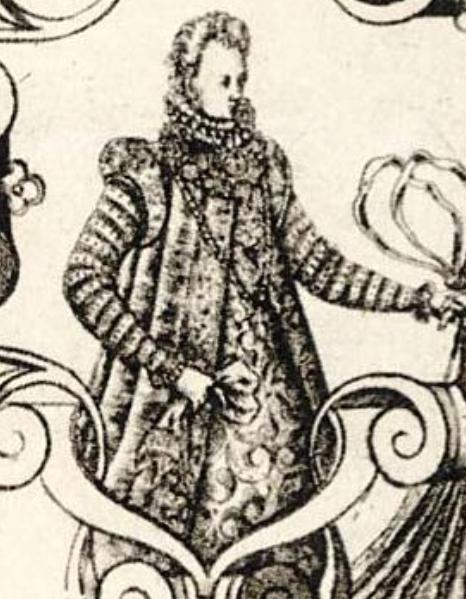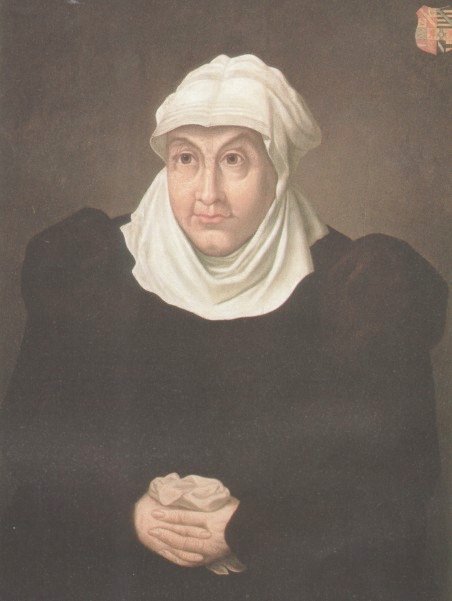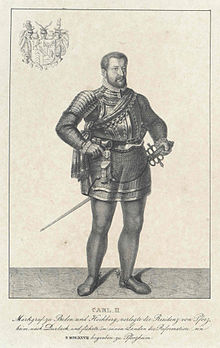Juan Jorge I, elector de Sajonia (Dresde, 5 de marzo de 1585 - ibídem, 8 de octubre de 1656) fue un Elector de Sajonia, conde palatino hde Sajonia y Margrave de Meissen y Mísnia en 1611, y miembro de la Casa de Wettin.
Juan Jorge I fue hijo del elector de Sajonia Cristian I y de Sofía de Brandeburgo, sucesor de su hermano Cristián II.

Magdalena Sibilla de Hohenzollern (Königsberg, 31 de diciembre de 1586 - Dresde, 12 de febrero de 1659), fue una noble alemana, integrante de la Casa de Hohenzollern y a través de su matrimonio, princesa-electora de Sajonia.
Fue la última hija del duque Alberto Federico de Prusia y de la princesa María Leonor de Cléveris, hija del duque de Cléveris, Jülich y Berg, Guillermo V el Rico y de la archiduquesa austriaca María de Habsburgo-Jagellón.

Nikita Romanovich (Russian: Никита Романович) (born ca. 1522, died 23 April 1586), also known as Nikita Romanovich Zakharyin-Yuriev, was a Muscovite boyar in 1563. His grandson Mikhail Feodorovich (Tsar 1613-1645) founded the Romanov dynasty of Russian tsars.
He was a son of the boyar Roman Yurievich Zakharyin-Koshkin , okolnichiy (who died on 16 February 1543, and who gave his name to the Romanov dynasty of Russian monarchs), and of Roman Yurievich's wife Uliana Ivanovna, who died in 1579. Nikita Romanovich became the brother-in-law of Ivan IV of Russia, who married his sister Anastasia Romanovna in 1547. His great-grandfather was Zakhary Ivanovich Koshkin.
George Frederick of Baden-Durlach (30 January 1573 – 24 September 1638) was Margrave of Baden-Durlach from 1604 until his abdication in 1622. He also ruled Baden-Baden.
He was the third son of margrave Charles II of Baden-Durlach and his second wife, Anna of Veldenz. He was the youngest of eight children and was only four years old when his father died.

Friedrich I of Württemberg (19 August 1557, Montbéliard – 29 January 1608, Stuttgart) was the son of George of Mömpelgard and his wife Barbara of Hesse, daughter of Philip I, Landgrave of Hesse.

Sibylla of Anhalt (28 September 1564 – 26 October 1614) was an Ascanian princess of Anhalt who became Duchess ofWürttemberg by marriage to Duke Frederick I. She was the fourth (but third surviving) daughter of Joachim Ernest, Prince of Anhalt, by his first wife Agnes, daughter of Wolfgang I, Count of Barby-Mühlingen.
Sibylla was born in Bernburg in 1564. In 1577, her elder sister Anna Maria was relieved from her post as Imperial abbess ofGernrode and Frose in order to marry Joachim Frederick, eldest son and heir of the duke of Brieg; under pressure from her father, the Chapter elected Sibylla as her successor. Sibylla was confirmed in office by the emperor, Rudolph II. During her reign as Abbess the only record of her activities comes from an abbey document in which she invests the widow of Stefan Molitor (the first Evangelical Superintendent of the abbey) with a piece of land.

Maria of the Palatinate, (24 July 1561 in Heidelberg – 29 July 1589 in Eskilstuna), was a German Princess and a Swedish Princess and Duchess of Södermanland by marriage, the first spouse of the future King Charles IX of Sweden. She died before he became King, and was therefore never Queen.
Maria was born to Louis VI, Elector Palatine and Elisabeth of Hesse

Guillermo I de Nassau, llamado Guillermo el Rico (Dillenburg, 10 de abril de 1487 - Dillenburg, 6 de octubre de 1559), fue conde de Nassau-Dillenburg, de la Casa de Nassau.
Era el hijo menor de Juan V de Nassau-Dillenburg e Isabel de Hesse (hija del landgrave Enrique III de Hesse-Marburgo y Ana de Katzenelnbogen). Guillermo fue hermano del conde Enrique III de Nassau-Breda y padre de Guillermo de Orange, a quien dejó en herencia el principado de Orange.
La condesa Juliana de Stolberg-Wernigerode (Stolberg, actualmente Alemania, 15 de febrero de 1506 - Dillenburg, 18 de junio de1580) fue la madre de Guillermo de Orange, el principal impulsor durante el siglo XVI de la guerra de Flandes que los Países Bajoslibraron para conseguir su independencia del Imperio español.
Juliana era hija de Botho VIII de Stolberg-Wernigerode y Ana de Eppstein-Königstein. Educada en el catolicismo, cambió dos veces de confesión: la primera al luteranismo y después al calvinismo. Junto a su segundo marido fue convencida protestante, educando a sus hijos en esta doctrina. A la muerte de su segundo marido en 1559, vivió en el castillo de Dillenburg (Alemania), propiedad de su hijo Juan, donde murió en 1580.
Dedicó toda su vida al cuidado de sus hijos, especialmente de Guillermo. Cuando éste comenzó su rebelión contra Felipe II de España, Juliana le apoyó moral y económicamente, gracias a lo cual Guillermo pudo mantener su campaña contra los españoles en los Países Bajos.

Carlo II di Baden-Durlach (Pforzheim, 24 luglio 1529 – Durlach, 23 marzo 1577) fu Margravio di Baden-Durlach dal 1563 al 1577.
Figlio del Margravio Ernesto di Baden-Durlach e di sua moglie, Ursula di Rosenfeld, Carlo II fu un attivista tedesco della fazione protestante, tra i principati del Sacro Romano Impero. Nel 1555 introdusse i principi della Riforma nel Baden-Durlach, stato di cui aveva ottenuto la reggenza alla morte del padre, nel 1553.

No hay comentarios:
Publicar un comentario